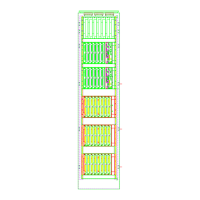maxPAC Hardware Reference Guide
Metso Automation MAX Controls Inc. • 277596 •
4-2
Bus Address
This module supports two modes of operation selected by jumper setting.
For use with DPU4A/B this module requires eight addresses and provides
seven channels.
When used with DPU4E, the module only requires two addresses and
provides eight channels.
Jumper Configuration
The module contains three jumpers. Refer to the following table for jumper
setting information.
Jumper Installed Not Installed
W2 Common I/O Redundant I/O
W3 50 Hz 60 Hz
W4 Not used
W6 DPU4A/B** DPU4E
** For version B or earlier, W7 must be installed for DPU4A/B operation
Module Operation
This microprocessor-based module supports up to 8 RTD inputs, which can
be independently configured. A reference excitation current is provided for
each input. A sigma delta A/D reads the voltage generated by one of the
eight inputs and converts the differential measurement to a 15-bit plus sign
binary value representing the millivolt input, which is read by the
microcontroller.
Multiple readings are done for each channel to compensate for the error
introduced by the field wiring in 3-wire RTDs. The microcontroller initiates
the conversion and waits for the conversion to complete. The digital filter in
the oversampling A/D provides excellent 50/60 Hz normal mode rejection.
The A/D also provides a variable gain amplifier function. Prior to starting
each conversion, the microcontroller sets the gain required in the A/D and
selects the RTD excitation current based on the configuration for that input.
It also selects the input channel by means of four solid-state optically
coupled relays.
The inputs are multiplexed with optical relays to provide channel to channel
isolation. Immediately following each measurement, open RTD and over
range conditions are checked. A DC/DC converter provides isolated power
to the field side of the measuring circuit. Communication between the
microcontroller and the A/D is serial at 100kHz.
Optical isolators provide the isolation between the A/D and the serial logic
circuits. The microprocessor provides the input data to the DPU on demand

